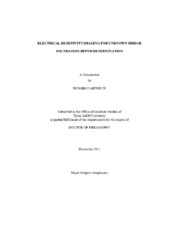| dc.contributor.advisor | Everett, Mark E. | |
| dc.creator | Arjwech, Rungroj | |
| dc.date.accessioned | 2012-02-14T22:20:12Z | |
| dc.date.accessioned | 2012-02-16T16:15:12Z | |
| dc.date.available | 2012-02-14T22:20:12Z | |
| dc.date.available | 2012-02-16T16:15:12Z | |
| dc.date.created | 2011-12 | |
| dc.date.issued | 2012-02-14 | |
| dc.date.submitted | December 2011 | |
| dc.identifier.uri | https://hdl.handle.net/1969.1/ETD-TAMU-2011-12-10484 | |
| dc.description.abstract | Unknown bridge foundations pose a significant safety risk due to stream scour and erosion. Records from older structures may be non-existent, incomplete, or incorrect. Nondestructive and inexpensive geophysical methods have been identified as suitable to investigate unknown bridge foundations. The objective of the present study is to apply advanced 2D electrical resistivity imaging (ERI) in order to identify depth of unknown bridge foundations.
A survey procedure is carried out in mixed terrain water and land environments with rough topography. A conventional resistivity survey procedure is used with the electrodes installed on the stream banks. However, some electrodes must be adapted for underwater use. Tests were conducted in one laboratory experimentation and at five field experimentations located at three roadway bridges, a geotechnical test site, and a railway bridge. The first experimentation was at the bridges with the smallest foundations, later working up in size to larger drilled shafts and spread footings. Both known to unknown foundations were investigated. The geotechnical test site is used as an experimental site for 2D and 3D ERI. The data acquisition is carried out along 2D profile with a linear array in the dipole-dipole configuration. The data collections have been carried out using electrodes deployed directly across smaller foundations. Electrodes are deployed in proximity to larger foundations to image them from the side. The 2D ERI can detect the presence of a bridge foundation but is unable to resolve its precise shape and depth. Increasing the spatial extent of the foundation permits better image of its shape and depth. Using electrode < 1 m to detect a slender foundation < 1 m in diameter is not feasible.
The 2D ERI method that has been widely used for land surface surveys presently can be adapted effectively in water-covered environments. The method is the most appropriate geophysical method for determination of unknown bridge foundations. Fully 3D ERI method at bridge sites is labor intensive, time consuming, and does not add enough value over 2D ERI to make it worthwhile. | en |
| dc.format.mimetype | application/pdf | |
| dc.language.iso | en_US | |
| dc.subject | Electrical Resistivity Imaging | en |
| dc.subject | Unknown Bridge Foundation Depth Determination | en |
| dc.title | Electrical Resistivity Imaging for Unknown Bridge Foundation Depth Determination | en |
| dc.type | Thesis | en |
| thesis.degree.department | Geology and Geophysics | en |
| thesis.degree.discipline | Geophysics | en |
| thesis.degree.grantor | Texas A&M University | en |
| thesis.degree.name | Doctor of Philosophy | en |
| thesis.degree.level | Doctoral | en |
| dc.contributor.committeeMember | Briaud, Jean-Louis | |
| dc.contributor.committeeMember | Carlson, Richard L. | |
| dc.contributor.committeeMember | Duan, Benchun | |
| dc.contributor.committeeMember | Kronenberg, Andreas K. | |
| dc.type.genre | thesis | en |
| dc.type.material | text | en |


